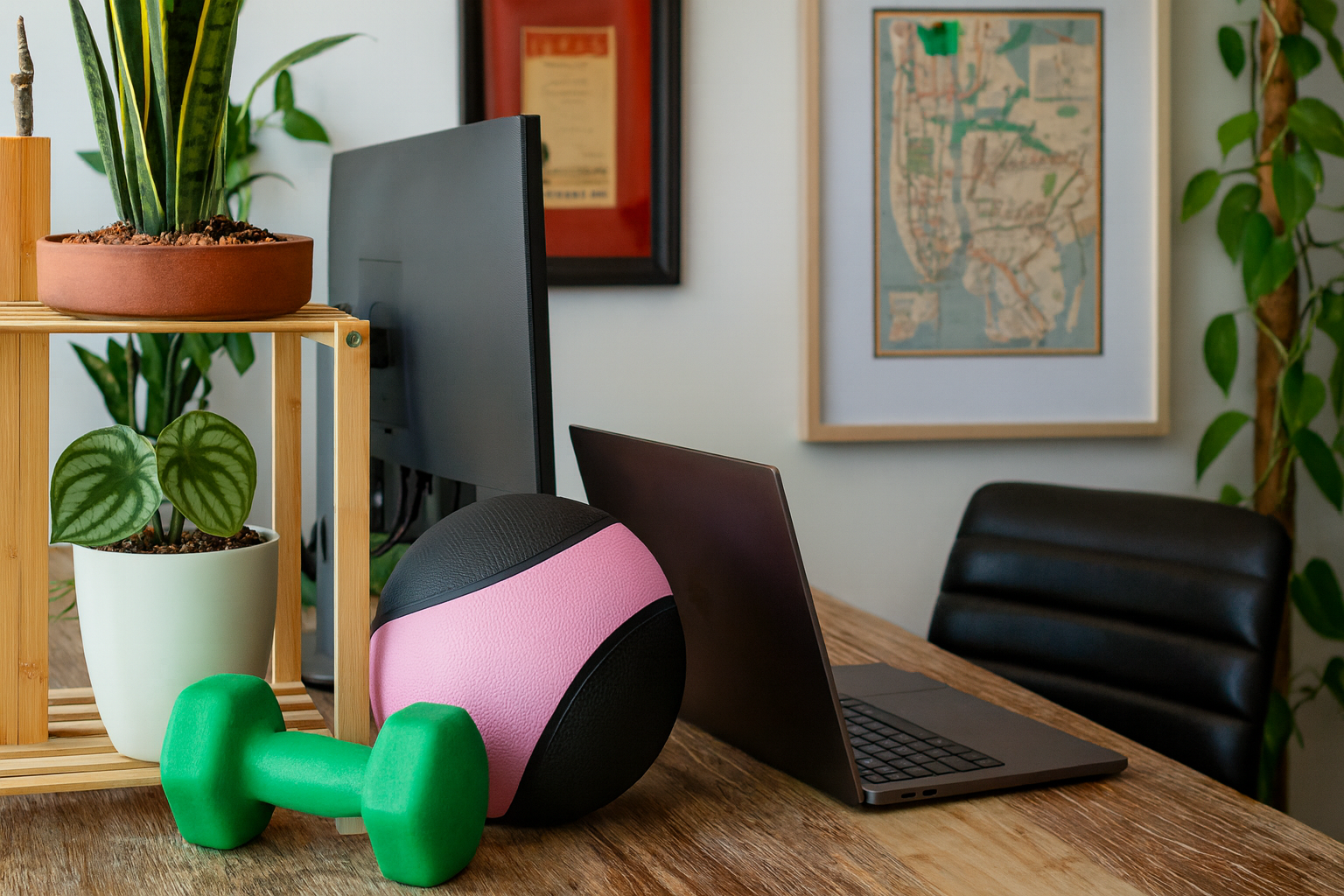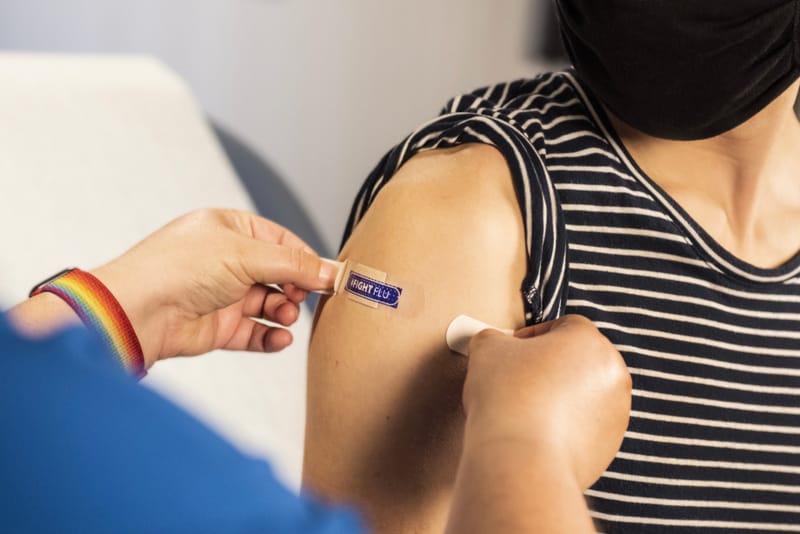Desk exercises you can do at work: Quick routines, strength builders, and posture-friendly stretches
A practical desk-exercise guide with warm-ups, posture fixes, seated core moves, standing strength, quick cardio bursts, wrist relief, and breathing resets—organized by time and workspace so you can stay healthy at your desk.
Most of us spend the bulk of our workday sitting, and that stillness takes a toll. Long periods at a desk slow circulation, tighten the hips and back, and sap your energy. Over time, poor posture and limited movement can add up to pain, fatigue, and even higher long-term health risks.
The good news: you don’t need a gym break to fight back. Simple desk exercises can restore posture, boost blood flow, and recharge your focus in just a few minutes. This guide gathers a full set of options—everything from discreet seated stretches to quick strength moves you can do before a meeting.
You’ll find exercises organized by time, space, and goal, so you can choose what fits your day. Always move within a comfortable range—mild stretch or muscle activation is normal, but sharp pain or dizziness is not. Modify or skip any movement that doesn’t feel right for your body.
How to Use This Guide
- Choose by time: Just 60 seconds? Try a 1-minute reset. Got a gap between meetings? Use a 5-minute mini-circuit. Need a proper recharge? Go for the 10-minute block.
- Choose by space: Some moves keep you seated and subtle, others ask you to stand for more intensity.
- Choose by goal: Whether you want mobility (stretching and posture resets), strength (core, legs, arms), cardio bursts (heart-rate up), or calm (breathing drills), you’ll find exercises mapped to each.
Three starter routines:
- 1-Minute Micro Reset: Neck rolls → wrist circles → seated toe-taps → 4-7-8 breathing.
- 5-Minute Mini Circuit: Lower-back stretch → spinal twist → seated leg extensions → desk plank → chair calf raises.
- 10-Minute Power Block: Squats → desk push-ups → oblique twists → seated leg pull-ins → chair dips → side stretches → 4-7-8 breathing.
Quick Routines (plug-and-play)
Sometimes you don’t need a long workout—just a fast reset to shake off stiffness, refocus, or get your energy back. These plug-and-play routines are designed around how much time you have. Follow them step by step, or swap moves based on your space and comfort.
1-Minute Micro Reset (no equipment)
Perfect for a quick break between emails or calls.
- Neck rolls: Sit tall, slowly circle your head clockwise for 10 seconds, then counterclockwise for 10 seconds.
- Wrist circles: Rotate both wrists in one direction for 10 seconds, then switch.
- Seated toe-taps: Tap your toes alternately against the floor as if jogging, 15–20 seconds.
- 4-7-8 breathing: Inhale for 4 counts, hold for 7, exhale for 8. Repeat one cycle.
5-Minute Mini Circuit
A balanced mix of mobility, strength, and posture work.
- Lower-back stretch: Stand or stay seated; fold forward to reach for your toes or toward the floor. Hold for 20–30 seconds.
- Spinal twist: Sit sideways, grip the back of your chair, and rotate gently. Hold 10 seconds each side.
- Seated leg extensions: Extend one leg straight, hold 5 seconds, then lower. Do 5 reps each side.
- Desk plank: Place hands on desk edge, step back into a straight line, hold 20–30 seconds.
- Chair calf raises: Sit tall and lift your heels off the ground, hold briefly, then lower. Do 10 reps.
10-Minute Power Block
Great for a midday energy boost or end-of-day reset.
- Squats: Stand with feet shoulder-width, lower toward the chair, then rise. Do 15 reps.
- Desk push-ups: Hands on desk edge, body straight, lower chest toward desk, push back up. Do 10 reps.
- Oblique twists: Sit at chair’s edge, lean back slightly, arms out front, rotate torso side to side. 5 twists each direction.
- Seated leg pull-ins: Lean back, draw knees to chest, extend out again. Do 10 reps.
- Chair dips: Hands on chair edge, slide forward, lower elbows to 90°, then push back up. Do 8 reps.
- Side stretches: Reach one arm overhead, bend gently to opposite side. Hold 10 seconds per side.
- 4-7-8 breathing: End with one to two cycles to calm and refocus.
Seated Mobility & Posture (feel better fast)
Long hours at a desk tighten the neck, shoulders, and lower back while putting extra strain on the wrists. These simple moves release tension, improve posture, and can be done right in your chair. They’re short enough to repeat every hour and effective enough to make a difference by the end of the day.
Neck rolls
Sit tall, shoulders relaxed. Slowly circle your head clockwise for 10–15 seconds, then reverse. Keep the motion controlled—avoid throwing your head back.
Lower-back stretch
- Standing option: Stand, hinge at the hips, and reach for your toes. Hold 20–30 seconds.
- Seated option: Stay in your chair, spread knees shoulder-width, and let your torso and head fold toward the floor.
Spinal twist (seated)
Sit sideways in your chair, feet flat. Hold the backrest with both hands and gently rotate your torso toward it. Hold 10–15 seconds, then switch sides.
Side stretches (overhead side bend)
Raise one arm overhead and lean gently to the opposite side as if reaching for something high. Hold 10 seconds, then switch.
Carpal-tunnel wrist series
- Flexor stretch: Arm out straight, palm up. With the other hand, gently pull fingers down and back. Hold 15 seconds.
- Extensor stretch: Arm out, palm down. Gently pull fingers toward the body. Hold 15 seconds.
- Wrist circles: Rotate wrists slowly 10–15 seconds each direction.
“Praying hands” wrist stretch
Bring palms together in front of your chest. Keeping elbows out, lower hands toward your waist until you feel a stretch in your wrists and forearms. Hold 10–20 seconds.
Why these help: These stretches counteract screen posture, release stiffness, and keep blood flowing.
How to dose: Hold each move for 30–60 seconds; cycle through 1–3 rounds during the workday.
Seated Core (no one will notice)
You don’t need a yoga mat or a gym to work your abs—just your chair. These discreet seated core moves activate your midsection, improve posture, and strengthen the muscles that support your spine. Done slowly and with control, they’ll build endurance without anyone in the office noticing.
Seated leg pull-ins (knee tucks)
Sit on the front edge of your chair, lean back slightly with hands gripping the sides for support. Draw your knees toward your chest, then extend your legs out at a 45° angle. Keep your back straight and core tight. Repeat 10–15 reps.
Seated crunches (“easy ab crunches”)
Sit tall, hands interlaced behind your head. Lean back until your upper back grazes the chair, then crunch forward, bringing your right elbow toward your left knee. Return to start and repeat on the other side. Do 10 reps per side.
Oblique squeezes (lateral crunch)
Sit upright, feet flat. Place your left hand behind your head, right arm relaxed. Engage your left obliques and bend sideways, lifting your left hip slightly. Return to upright. Perform 10 reps, then switch sides.
Oblique twist (arms extended)
Sit at the edge of your chair with feet flat. Extend both arms straight out in front of you. Lean back slightly, brace your core, and twist your torso slowly side to side, keeping arms aligned with your chest. Do 5–8 reps each direction.
Seated reverse jackknives
Sit near the chair’s edge, lean back with your torso, and extend legs straight out in front. Pull both knees toward your chest while bringing your upper body forward in a crunch motion. Extend back out and repeat for 8–12 reps.
Tip: Focus on controlled movement and steady breathing. It’s better to perform fewer reps slowly than to rush and strain your lower back.
Isometrics (stealth strength)
Isometrics are strength exercises where you contract muscles without moving your joints. They’re perfect for the office because they look like you’re just sitting still. These moves activate your core, arms, and legs without needing space or equipment—ideal for “stealth training” between emails.
Glute squeezes (“butt clenches”)
Sit tall in your chair, feet flat. Squeeze your glutes as hard as you can, hold for 6–10 seconds, then relax. Repeat 6–10 times.
Desk push (core press against desk)
Stand or sit close to your desk. Place both palms flat on the surface and push downward and slightly forward as if you’re trying to shove it through the floor. Engage your core and hold for 6–10 seconds.
Hand press (palms together)
Bring your palms together in front of your chest, elbows out. Press your hands firmly together as if crushing an invisible ball. Hold for 6–10 seconds, then release. Works chest, biceps, and triceps.
Thigh press (knees vs. palms)
Sit upright with feet flat. Place your palms against the outside of your knees. Push outward with your knees while pressing inward with your palms to resist. Hold for 6–10 seconds, repeat 6–10 times.
Desk curls (under-desk press)
Sit with your chair close to the desk, elbow bent at 90 degrees. Place your fist or palm under the desk and press upward as if curling a dumbbell against resistance. Hold for 6–10 seconds, relax, and repeat.
How to dose: 6–10-second holds, 6–10 reps each, for 1–2 sets anytime you need a discreet strength break.
Upper-Body & Core at the Desk Edge
If you have a sturdy desk or chair, you can use it to turn simple movements into effective strength training. These exercises target your chest, arms, shoulders, and core, helping balance out all the sitting and typing that tighten the front of your body.
Desk plank (incline)
Stand facing your desk, place hands shoulder-width apart on the edge, and step your feet back until your body forms a straight line from head to heels. Engage your abs and glutes. Hold 20–30 seconds, breathing steadily.
Desk push-ups (incline)
From the plank position, bend your elbows to lower your chest toward the desk, keeping your body straight. Push back to the starting position. Aim for 8–12 controlled reps.
Chair dips
Using a stable chair, sit on the edge with hands gripping beside your hips. Slide forward so your hips are just off the chair, bend elbows to lower until arms are at about 90°, then press back up. Start with 6–8 reps.
Chair lifts (armrest hold)
Sit near the edge of a sturdy chair with armrests. Grip the rests, engage your core, and lift your body a few inches off the seat. Hold for 5–10 seconds before lowering back down. Repeat 5–8 times.
Progression: Start with a wall push-up or wall plank if you’re new. Move to the desk for more challenge, then to a lower surface for maximum intensity. Always prioritize form over reps.
Lower-Body Strength (chair support optional)
Your legs and glutes are the body’s largest muscle groups, and strengthening them offsets the long hours of sitting that weaken hips and tighten hamstrings. These moves can be done with or without a chair for support and require no equipment.
Squats
Stand with feet shoulder-width apart, arms extended in front for balance. Bend your knees and drive your hips back as if sitting into a chair, keeping your chest lifted. Lower until thighs are parallel to the ground (or as far as comfortable), then press back to standing. Aim for 10–15 reps.
Chair squats
Stand in front of a sturdy chair with feet shoulder-width. Lower yourself toward the seat until you lightly touch it, then rise back up before sitting fully. Repeat 8–12 reps. Great for building control and confidence.
Seated leg extension (quads)
Sit upright with thighs parallel to the floor. Extend one leg straight out, foot flexed, and hold briefly before lowering. Perform 8–10 reps per side. To increase difficulty, add ankle weights.
Chair calf raises (seated → standing → weighted)
- Seated: Sit tall with feet flat. Raise your heels as high as possible, pause, then lower.
- Standing: Stand behind your chair, hold lightly for balance, and lift onto your toes.
- Weighted: Place a backpack or light object on your lap (seated) to add resistance. Do 10–15 reps.
Cue: Always keep knees tracking over the mid-foot—avoid letting them collapse inward. This protects your joints and ensures proper form.
Quick Cardio Bursts (wake-up options)
When the afternoon slump hits, quick cardio bursts are the fastest way to lift your energy and circulation. These simple moves get your heart rate up without needing gym clothes or extra space.
Jog in place (standing, 60s)
Stand tall near your desk and jog lightly in place. Swing your arms naturally and lift your knees to hip height if possible. Continue for 30–60 seconds.
“Run” in place while sitting
Stay seated, scoot slightly forward in your chair, and mimic a running motion by pumping your arms and legs. Lift knees high for more intensity. Go for 30–45 seconds.
Toe taps / seated toe-taps
From your chair, tap your toes rapidly against the floor in an alternating pattern, as if you were jogging. Do this for 20–30 seconds to boost circulation in your legs.
March in place at a standing desk
If you use a sit-stand desk, lift one knee at a time to waist height while swinging your arms. March briskly for 30–60 seconds, focusing on posture and rhythm.
Programming: Use these bursts between meetings or tasks. Aim for 30–60 seconds per move, and stack 2–3 exercises for a mini cardio circuit whenever you need to wake up.
Breathing & Downshift (focus + recovery)
Not every reset needs to be physical. A short breathing ritual can calm your nervous system, lower stress, and help you refocus when the day feels overwhelming. The 4-7-8 technique is simple, discreet, and effective whether you’re at your desk, in a meeting room, or winding down after a quick exercise block.
4-7-8 breathing ritual
- Sit upright with feet flat on the floor and shoulders relaxed.
- Inhale quietly through your nose for a count of 4.
- Hold your breath gently for a count of 7.
- Exhale fully through your mouth for a count of 8, keeping the tip of your tongue just behind your top teeth.
Repeat 1–3 cycles, or more if time allows.
When to use: Pre-call nerves, right after finishing a circuit of desk exercises, or during a mid-afternoon slump when you need a reset without more caffeine.
Workspace Tweaks (passive wins)
Not every improvement comes from exercise. Small workspace adjustments can keep your body engaged and reduce the wear-and-tear of long sitting hours. Think of these as passive wins: changes that support health even when you’re deep in focus.
Active sitting / stability ball hour
Swap your chair for a stability ball for 30–60 minutes a day. Sitting on the ball forces your core to engage as you balance, which strengthens your midsection and encourages upright posture.
- Form cue: Keep your shoulders back, abs lightly braced, and avoid slouching.
- Ball size guide:
- 4’5” or shorter → 12" ball
- 4’6”–5’0” → 18" ball
- 5’1”–5’7” → 22" ball
- 5’8”–6’2” → 26" ball
- 6’3”+ → 30" ball
Posture checklist
Do a quick scan whenever you sit down:
- Screen at eye level, arm’s length away.
- Hips back in the chair, lower back supported.
- Feet flat on the floor, knees at about 90°.
- Shoulders relaxed, not hunched.
Movement prompts
Use reminders to break up sitting before stiffness sets in.
- Hourly reset: Stand, stretch, or walk for 1–2 minutes.
- Water timer: Keep a water bottle at your desk and use refills as a cue to move.
- Digital nudge: Set calendar alerts or use a task app to prompt posture checks.
These tweaks don’t replace exercise, but they create an environment that supports movement and makes healthy choices automatic.
Starter Schedules (habit scaffolding)
Even with the best intentions, it’s easy to let movement slip when the workday fills up. These sample schedules give you plug-and-play routines that fit naturally into your day. Use them as scaffolding until the habit sticks, then adjust based on your time and energy.
“Every Hour on the Hour” (90 seconds)
A quick reset to keep stiffness from building up.
- Neck rolls
- Wrist stretch (flexor or extensor)
- Toe-taps (20–30 seconds)
“Between Emails” (3 minutes)
A short burst that mixes strength, posture, and calm.
- Desk plank (20–30 seconds)
- Chair squats (8–10 reps)
- Side stretch (10 seconds each side)
- 4-7-8 breathing (1 cycle)
“After Lunch” (8–10 minutes)
A fuller routine to re-energize for the afternoon.
- Squats (12–15 reps)
- Desk push-ups (8–12 reps)
- Seated leg pull-ins (10 reps)
- Chair calf raises (10–12 reps)
- Spinal twist (10–15 seconds each side)
These scaffolds aren’t rigid workouts—think of them as anchors to remind you that movement can fit into any schedule.
FAQs
What if I only have 60 seconds?
Use the 1-minute micro reset: neck rolls, wrist stretch, toe-taps, and one cycle of 4-7-8 breathing.
Will this replace my gym time?
Not entirely. These exercises complement formal workouts. Aim for at least 150 minutes of weekly activity total, as recommended by health guidelines.
What if my chair has wheels?
Lock the wheels or choose a stable surface before doing dips, lifts, or any move that requires support.
How do I progress?
Increase the length of holds, slow down your tempo for control, add extra sets, or move from wall → desk → lower surface for planks and push-ups.
Safety & Accessibility
Desk exercises should feel like gentle effort, not strain. Keep these points in mind to stay safe:
- Listen to your body: Stop immediately if you feel sharp pain, numbness, or dizziness.
- Modify as needed: Adjust your range of motion and use a wall, desk, or chair for extra support.
- Medical considerations: If you’ve had recent injuries, surgery, or ongoing health issues, check with a clinician before starting new movements.
These guidelines help ensure the exercises remain safe, accessible, and adaptable for a wide range of people and work environments.
See the Sources Behind these Desk Exercises
This guide draws on evidence-based desk exercise routines and core-strengthening strategies from the following sources:
- Venus Treatments—How to Strengthen Your Core While Sitting at Your Desk
- Slendertone—Achieve a Stronger Core While Working from Your Desk
- Cleveland Clinic—6 Desk Exercises That Help You Get Stronger While Working
- Todoist—15 Incredibly Simple Desk Exercises You Can Do at Work







